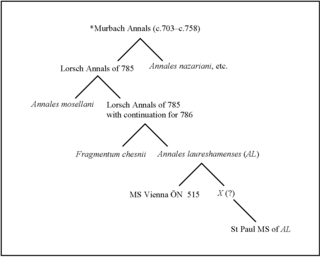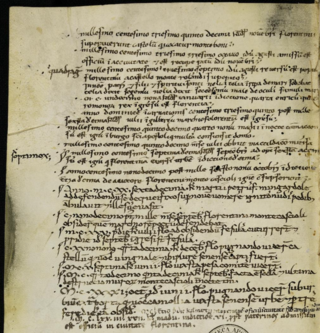Flodoard of Reims was a Frankish chronicler and priest of the cathedral church of Reims in the West Frankish kingdom during the decades following the dissolution of the Carolingian Empire. His historical writings are major sources for the history of Western Europe, especially France, in the early and mid-tenth century.

The Royal Frankish Annals, also called the Annales Laurissenses maiores, are a series of annals composed in Latin in the Carolingian Francia, recording year-by-year the state of the monarchy from 741 to 829. Their authorship is unknown, though Wilhelm von Giesebrecht suggested that Arno of Salzburg was the author of an early section surviving in the copy at Lorsch Abbey. The Annals are believed to have been composed in successive sections by different authors, and then compiled.

The Battle of Tertry was an important engagement in Merovingian Gaul between the forces of Austrasia under Pepin II on one side and those of Neustria and Burgundy on the other. It took place in 687 at Tertry, Somme, and the battle is presented as an heroic account in the Annales mettenses priores. After achieving victory on the battlefield at Tertry, the Austrasians dictated the political future of the Neustrians.
The Reichsannalen are a class of annals composed anonymously in the Carolingian Empire throughout the 9th century. They first appeared under Pepin the Short in 741 and became ubiquitous at monasteries throughout the empire in the following decades. They were not official court annals, but they often bear the bias of having been written in one regnum or another.

The Annales Xantenses or Annals of Xanten are a series of annals which adapt and continue the Royal Frankish Annals. Their first editor, Georg Pertz, thought they were perhaps written at the monastery at Xanten, hence their name. However, according to Heinz Löwe, the entries from 790 to around 860 were probably written at Lorsch by Gerward, a royal chaplain. Löwe suggests that the manuscript subsequently passed to Cologne, and around 871 new entries were written there, for the years from 861 onwards. This part of the text is hostile to Archbishop Gunthar of Cologne.

Chelles Abbey was a Frankish monastery founded around 657/660 during the early medieval period. It was intended initially as a monastery for women; then its reputation for great learning grew, and when men wanted to follow the monastic life, a parallel male community was established, creating a double monastery.
The Annals of Metz are a set of Latin Carolingian annals covering the period of Frankish history from the victory of Pepin II in the Battle of Tertry (687) to the time of writing. Although the annals do cover events following 806, these sections are not original writings but are additions borrowed from other texts and appended to the original annals in the 9th and 12th centuries.

The Annales laureshamenses, also called Annals of Lorsch (AL), are a set of Reichsannalen that cover the years from 703 to 803, with a brief prologue. The annals begin where the "Chronica minora" of the Anglo-Saxon historian Bede leaves off—in the fifth year of the Emperor Tiberios III—and may have originally been composed as a continuation of Bede. The annals for the years up to 785 were written at the Abbey of Lorsch, but are dependent on earlier sources. Those for the years from 785 onward form an independent source and provide especially important coverage of the imperial coronation of Charlemagne in 800. The Annales laureshamenses have been translated into English.

The Fragmentum (annalium) chesnii or chesnianum, sometimes called the Annales Laureshamenses antiquiores, is a brief set of Reichsannalen describing the history of Francia during the years 768 to 790. It is named after André Duchesne, who first edited and published it in his book Historiae Francorum scriptores (1:21–23) in 1636. It has been re-edited by Georg Heinrich Pertz for the Monumenta Germaniae Historica, Scriptores I, 30–34.

The Annales mosellani or mosellenses (AM) or Moselle Annals are a set of minor Reichsannalen covering the years 703 to 798. Its entries are brief and unliterary, but broad in scope and generally accurate. They have only partially been translated into English.
The Annales guelferbytani are a set of Latin annals covering the years 741–805 that were composed in Regensburg, the capital of the Duchy of Bavaria, in 812–13. They are found in a manuscript of the ducal library of Wolfenbüttel, which contains fourteen folios, though folio 13r was added later and folios 13v–14v later still.

The Chronica regia Coloniensis, also called the Annales Colonienses maximi, is an anonymous medieval Latin chronicle that covers the years 576 to 1202. The original chronicle only went up to 1197, but a continuator later added the following few years' events. According to the historian Manfred Groten, the Chronica was probably first compiled about 1177 in Michaelsberg Abbey, Siegburg, and then continued in Cologne. The earliest manuscript only contains an account down to 1175.
The Annales Petaviani (AP) is one of the so-called "minor annals group", three related Reichsannalen, year-by-year histories of the Carolingian empire composed in Latin. They are named after the former owner of the manuscript, the French Jesuit Denis Pétau (1583–1652), whose name, in Latin, is Dionysius Petavius. The standard critical edition of the Annales is that of Georg Pertz in the Monumenta Germaniae Historica.

The Annales florentini are the earliest annals of the medieval commune of Florence. They are written in Latin. There are two sets of annals overlapping in coverage: the Annales florentini primi covering the period 1110–1173 and the Annales florentini secundi covering 1107–1247. A later set covers the period 1288–1431.
The Annales Beneventani, also called the Breve chronicon monasterii Sanctae Sophiae Beneventi or Chronicon Sanctae Sophiae for short, is a series of Latin annals from the monastery of Santa Sofia in Benevento, southern Italy. The annal entries were originally annotations written in the margins of Paschal tables, a practice that probably dates to the foundation of the monastery in the second half of the eighth century. The annotations were gathered together and copied into manuscripts in the early twelfth century. Three such manuscripts exist, each copied at Santa Sofia and each presenting a different redaction of the annals. The Annales is of interest primarily because its entries are roughly contemporaneous with the events they describe.

Annales Laurissenses minores or ALM is the Latin name of a medieval, historiographic text from the abbey at Lorsch near Worms in Germany. In many German texts, they are also called the Kleine Lorscher Frankenchronik, but in English may be referred to as the "Short chronicle of Lorsch" or "Lesser Annals of Lorsch".
The Historia Francorum Senonensis is a short anonymous Latin chronicle of the Frankish kings from 688 down to 1015. It was written at Sens before 1034 and is hostile towards the Capetian dynasty that had taken the throne of West Francia in 987. It was a popular and widely used text, and its anti-Capetian view is largely responsible for the questions raised by many later authors concerning the dynasty's legitimacy.
The Annals of Aachen is an anonymous late 12th-century compilation of Latin annals from St Mary's Church in Aachen. The annals were originally compiled in 1169 and subsequently extended down to 1196. The first part is little more than a list of Roman emperors from AD 1 until 684. Entries for the years 688–809 were borrowed from some Carolingian imperial annals and are closely related to the Annals of Saint-Amand. There follows a list of Carolingian and German rulers down to 1109. The reports on the reign of Henry V (1105–1125) are generally positive. The coverage of the Staufer rulers is also positive.

The Chronicon universale usque ad annum 741 is an anonymous Latin chronicle from the creation of the world to AD 741. It was written in Francia, probably in Burgundy, between 741 and 775. It survives wholly or partially in at least six manuscripts.
The Annales Tiliani are an anonymous set of Latin annals from the Frankish kingdom, covering the years 708–807. They are considered minor annals.